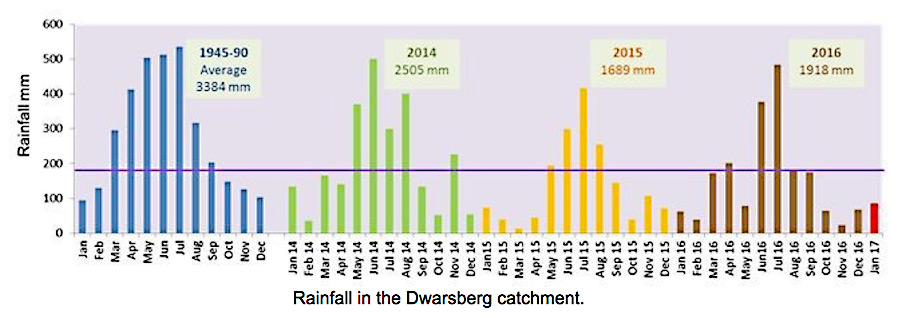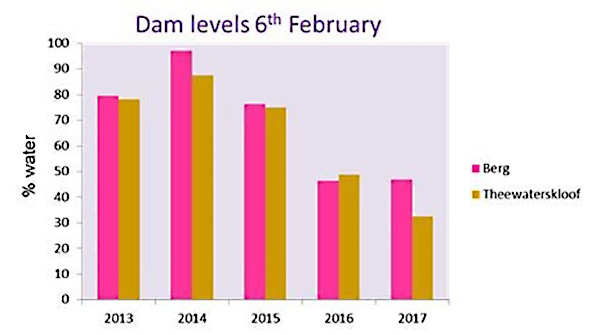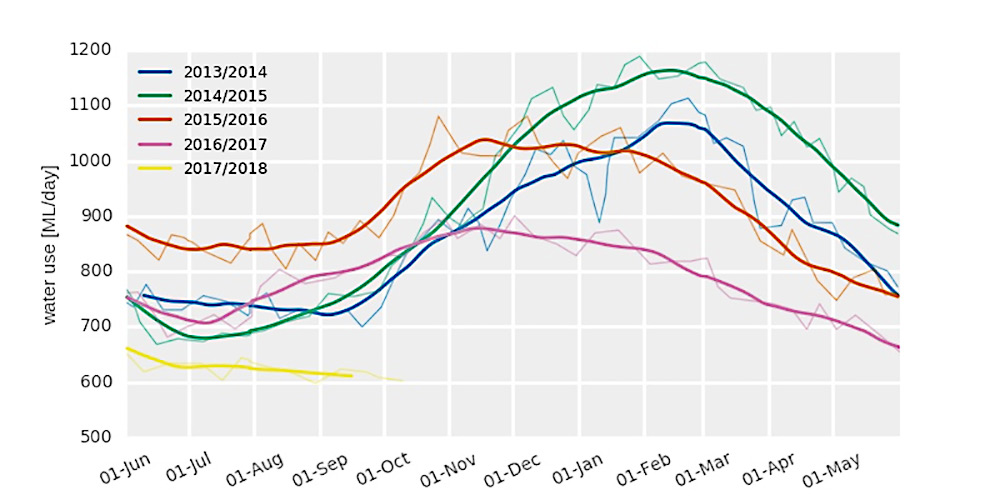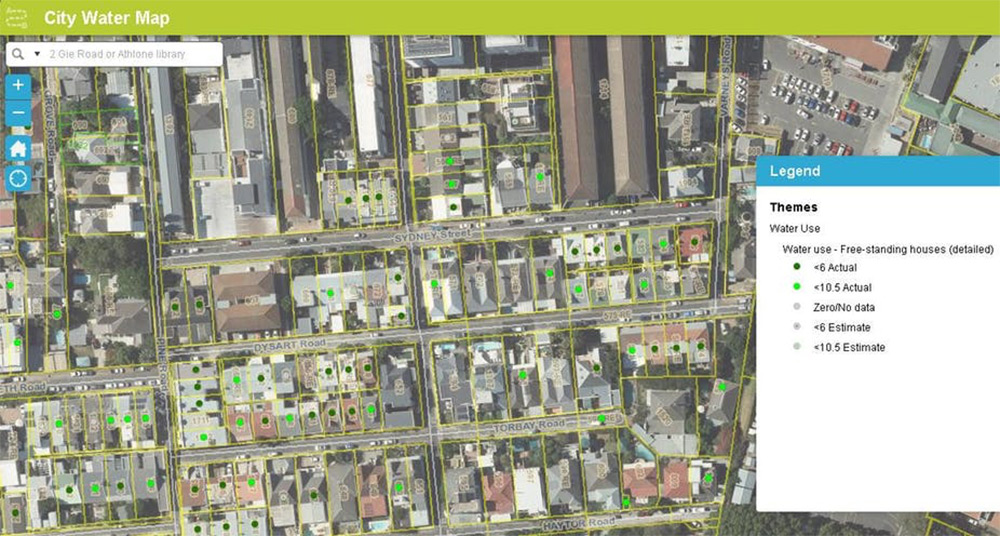
Cape Town’s Water Crisis – What lessons can be learned?
Posted on: July 2018Cath Hassell www.ech2o.co.uk
 |
Cath Hassell is an expert in sustainable water strategies and low-carbon technologies, formed from a background of 17 years in the plumbing industry and 16 years in environmental building. She is director of ech2o consultants ltd, a company that works at both a strategic and individual site level, providing technological and behavioural solutions that reduce the UK’s carbon footprint. Cath is a founder member of SWIG (the Sustainable Water Industry Group) and was a director of the AECB for seven years. Fascinated by how we use water she writes a regular column for Green Building Magazine, a water blog for the AECB and blogs about showering at a year of showering variously. She talks to a wide range of audiences across the UK about environmental issues. www.ech2o.co.uk |
WatEf blog 2018 March 1st 2018
Cape Town’s Water Crisis
What lessons can be learned?
Cape Town’s water crisis is now big news globally, though it has been exercising the minds of the four million city dwellers since this time last year. As I write this blog 'Day Zero' is now July 9th (a grace period of almost three months since the beginning of February when it was estimated to be mid-April) and still too close for comfort. Day Zero is when the water level in the six dams (reservoirs) that feed the city will reach 13.5% of capacity (3.5% of useable capacity), the supply to the city will be cut off completely and water will only be available (and rationed) from stand pipes in the street. So how did Cape Town get here - to the likely scenario of a legally guaranteed minimum of just 25 litres/person/day within 200 m of every citizens home? And what lessons can be learnt for other cities in the world?
Cape Town rainfall
Cape Town is in the Western Cape of South Africa which has a Mediterranean climate with cool, wet winters and warm, dry summers. It has two dominant rainfall zones, the winter and the bimodal (spring and autumn) rainfall regimes. It is the winter rains that are the most important for refilling the dams that the city relies upon for its water supplies. Average annual rainfall figures in and around Cape Town vary widely. Just 515mm falls at Cape Town International Airport (on the eastern edge of the city) while 1,395mm falls at Kirstenbosch National Botanical Garden, (on the lower slopes of Table Mountain) in the west of the city 13 miles away. But it is rainfall in the Dwarsberg catchment (where average annual rainfall is 3,384mm) that is most important for the city’s water supply as this is the area that supplies the Theewaterskloof and Berg River Dams, which between them provide two thirds of Cape Town’s water reserves.

Although the rainfall in 2014 was just 75% of average, the dams managed to fill up to 100% during winter and hold this water through the summer months. But two years of poor rainfall in 2015 (just 50% of average) and 2016 (57% of average) meant that the dams did not refill fully and by February 2017 were both less than 40% full.

Levels of dams fed by the Dwarsberg catchment on 6th February 2013-2017.
The situation was then made immeasurably worse by the fact that 2017 was one of the driest years in recent decades and the water supply system was not designed for three years of drought. By 26th February 2018, Theewaterskloof dam was at 11.1% compared to 28.6 % at the same time in 2017. And all six dams combined were at 24% compared to 33% in 2017.
Water restrictions
There were severe droughts in the 1920s and 1970s, but the city was smaller then. In 2003 during the region’s last drought, Cape Town implemented a plan of action to prevent leaks and water losses. The plan was so successful that the city has seen almost no increase in water demand in the last 15 years, despite a high increase in population growth. However, the industry of wine making has increased substantially and the Cape Town Winelands are a high user of municipal water, especially when the winter rains fail.
In January 2017 Cape Town reacted to the situation by lowering pipe pressure and introducing Level 4 water restrictions which banned external use apart from nurseries and agricultural activities (who could apply for an exemption) and required all private boreholes to be registered. On January 1st 2018 Level 6 water restrictions were imposed, a serious increase in the level of restrictions. As well as increased limits on external use, all residents are now restricted to no more than 87.5 litres of municipal drinking water per person per day and any residential property with four occupants is expected to use no more than 10,500 litres per month. Single residential properties consuming more than this amount of municipal drinking water per month will be ‘prioritised for enforcement’. All agricultural users of municipal water must ensure that their monthly consumption is reduced by 60%. Borehole water is no longer allowed for refill of swimming pools etc. to conserve groundwater supplies; if it is available it has to be used for WC flushing. Finally this seems to be having the desired effect. By 1st October 2017 (the end of the winter rains) the restrictions were already having a measurable effect. Water use had dropped to just over 600 Mega Litres (ML) a day compared to 800 ML the year before and daily water consumption has continued to fall. By February 2018 it was down to 540 ML from a high of almost 1,200 ML in February 2014 (before the drought).

Lessons to be learned
So the Level 6 restrictions have been successful but it is clear (in hindsight) that they should have been put into place earlier, when the situation was acute but manageable. It was as though the city was banking on the drought not continuing into a third year. The situation was also complicated by the national Government overriding the city government and protecting the wine growers who rely on municipal water for large amounts of their irrigation requirements. In 2015, the city of Cape Town was allocated 60% of the water from the Western Cape’s water supply system; almost all of the rest went to agriculture, particularly long-term crops like fruit and wine. The drought began to take its toll on provincial dam levels, yet the national Department of Water and Sanitation took no action to curtail agricultural water use in 2015/2016. It could be argued that it was the allocations to agriculture that have caused this crisis as they consumed Cape Town’s safety buffer of 28,000 ML.
Citizens are being exhorted to use less water than the daily maximum of 87.5 litres and data from meter reads is used to highlight ‘good’ water citizens - a tactic that is seen as controversial. However it is a long way removed from enforced disconnection or restricting flow into homes, both of which are used in some US States even in the absence of drought conditions for residents who don’t/can’t pay their bills. In the UK the roll out of smart meters has increased knowledge about when and where water is used in buildings. But they do not have the ability to control water supply remotely and anyway, by law water companies cannot cut off or restrict water flow to domestic customers. However that latter point could be waived in the event of Level 4 restrictions being applied in the UK, which can happen under an Emergency Drought Order.
The rains may arrive in May/June this year after all and the Level 6 restrictions will have done their job and disaster will have been averted. But what is clear is that if Cape Townians wish to revert to their former level of water consumption, then alternative sources of water will have to be found. The region’s current system is designed with the capacity to handle two years of below-average rainfall as droughts lasting much longer have historically been very rare. However, climate change may mean that longer drought periods become the norm. The town is currently exploring using either groundwater or desalination plants to supplement surface water, though the high price of desalination means groundwater is being favoured. Also, agriculture is likely to make more use of ground water. Of course, neither is a magic bullet. Ground water is not an infinite resource and desalination is very energy intensive.
So is this something we should be concerned about in the UK? Between May 1975 and August 1976, England and Wales suffered the driest 16-month period on record, and by the end of that period householders in Wales and the west of England were subjected daily to periods of water supply shutdown. In Yorkshire, East Anglia and Plymouth the mains water supply to properties was replaced by communal standpipes in the street. During the drought of 1995 in a bid to alleviate drastic shortages Yorkshire Water mobilised a convoy of 700 tankers which made 3,500 daily deliveries from east to west of the county to refill the western reservoirs. The emergency measures cost £3m a week and eventually led to the resignation of the then chief executive. And in 2006 the town of Crawley was only spared from accessing their water from standpipes by using an emergency supply of water pumped from Portsmouth 80 miles away. Since then improvements have led to a far more resilient water supply infrastructure across the UK but under the Drought Direction 2011 there is an allowance for Emergency Drought Orders to be granted that allows a water undertaker to limit the use of water for such purposes as it thinks fit and to supply water by means of standpipes, rota cuts or water tankers. Water companies in the UK are no doubt monitoring the situation in Cape Town closely.
Cath Hassell​​



